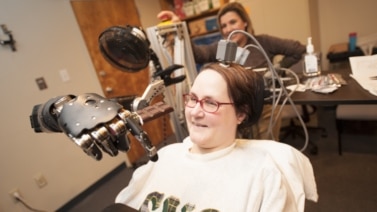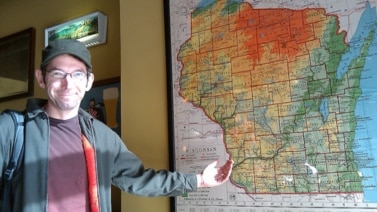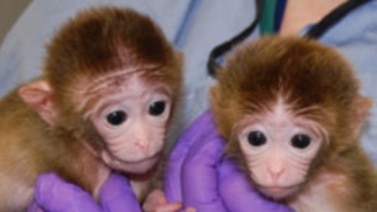VOICE ONE:
This is SCIENCE IN THE NEWS in VOA Special English. I'm Faith Lapidus.
VOICE TWO:
And I'm Shirley Griffith. On our program this week, we will examine efforts to defeat the disease polio.
(MUSIC)
VOICE ONE:
Pakistan is working to protect more than thirty million children from polio. Health workers are giving vaccine against the disease to children younger than five years.
Health officials in Pakistan plan to complete the current vaccination campaign next month. But the government says efforts against polio are always in progress. The efforts are part of an international campaign to stop the disease.
The struggle against polio has suffered unexpected problems. But it has also made major progress.
VOICE TWO:
The future also looks hopeful. A top polio expert at the World Health Organization has praised success with a vaccine against the fastest spreading kind of polio. Doctor David Heymann believes that this most threatening polio could be defeated this year. He also says vaccines are being developed to prevent a slower spreading version of the disease.
Prevention is especially important because antibiotic drugs cannot help after someone is infected. Antibiotics can kill only bacteria, not viruses.
The virus called wild poliovirus passes freely from person to person. Wild poliovirus spreads through fluids in the mouth, waste material and water systems. Another kind of polio is rare. Vaccine-derived, or vaccine-linked, polio strikes when harmful genetic changes affect the vaccine.
VOICE ONE:
Polio is mainly a children’s disease. But adults also get it. Many people are infected without knowing it. They may just have a higher than normal body temperature and pain in the throat. But when polio attacks the central nervous system, patients can be paralyzed. They may not be able to stand or walk. When the disease affects breathing, some patients die.
Polio paralyzed an estimated three hundred fifty thousand patients in nineteen eighty-eight. That same year, a coalition of health workers started the Global Polio Eradication Initiative. By last year, the number of new paralytic polio cases dropped to about seven hundred sixty-five.
VOICE TWO:
The Initiative coalition includes national governments and UNICEF -- the United Nations Children’s Fund. Another partner is the American Centers for Disease Control and Prevention. Still another is the volunteer service organization Rotary International. Other groups also take part.
(MUSIC)
VOICE ONE:
Scientists say three polioviruses cause wild polio. Type one is the most dangerous. Type one can infect many people in a short time. It has caused about eighty-five percent of all polio cases. Type two wild polio disappeared worldwide in nineteen ninety-nine. Cases caused by type three poliovirus do not spread as fast as polio caused by type one.
Today, polio continues to strike people in Nigeria, India, Afghanistan and Pakistan. In two thousand three, Nigeria stopped providing vaccine against polio for almost a year.
VOICE TWO:
False reports about the vaccine caused the stoppage. The reports said the vaccine gave people the disease AIDS. Other reports said it made people unable to have children. Nigeria reported many cases of polio after the vaccinations ended. The disease also spread to other nations.
By last August, however, the polio news in the nation seemed hopeful. Nigeria had reported a major reduction in polio cases after January. But then came an unwelcome report. Sixty-nine children in the northern part of the country had developed paralytic polio.
VOICE ONE:
Some of the infected children had received Sabin oral polio vaccine. The Global Polio Eradication Initiative provided the vaccine to young children. It is given by mouth several times during a child's earliest years.
The Sabin oral polio vaccine contains a live but weakened version of poliovirus. The weakened virus protects well against type one poliovirus. But in Nigeria, some of the vaccine had made a rare and harmful genetic change.
The children started getting sick with polio in two thousand six, or even earlier. But these cases were not announced until late September, two thousand seven.
Critics say the news should have been reported quickly. They say the delayed announcement helped to support the polio vaccine suspicions that had stopped vaccinations several years before.
VOICE TWO:
Rotary International made a public statement about the new polio cases in October of two thousand seven. The group said the vaccine did not, in itself, cause the children to get the disease.
Doctor Heymann of the WHO said the children with vaccine-linked polio were more likely than others to get infected. He said not enough vaccine had been provided in their area. The doctor noted that sixty of the children had not received any vaccine. Or, he said, they had not received enough vaccine to protect them.
Critics have questioned the continued use of the Sabin oral polio vaccine in the international campaign against polio. They say its link to infection with the disease makes the vaccine unacceptable. But Rotary International notes the vaccination's success over the years. It says the oral polio vaccine has reduced polio cases by ninety nine percent since the Global Polio Eradication Initiative began.
VOICE ONE:
Eight years ago, American health officials stopped saying people should be given the Sabin oral polio vaccine. They said the reason was to end the possibility of paralytic polio linked to the vaccine.
Olen Kew is an expert in viruses for the Centers for Disease Control. He led a team that studied vaccine-linked polio in two thousand five. He says the WHO is creating a program to develop a vaccine for use after polio is defeated. The new vaccine would not contain a live poliovirus. It could not cause polio.
VOICE TWO:
Jonas Salk developed the first major polio vaccine in the nineteen fifties. Albert Sabin then developed the Sabin oral polio vaccine in the nineteen sixties. Doctor Salk’s polio vaccine was injected. An improved version of this vaccine is now the one used in the United States.
The improved Salk vaccine contains inactive viruses. It cannot cause polio. But experts say the oral polio vaccine works faster against the spread of type one polio. And the Sabin vaccine is less costly. Health care workers who direct its use need little training.
WHO officials say only the oral poliovirus vaccine can quickly build very high body defenses against the disease. They say only this kind of vaccine can stop polio in developing countries with warm climates.
The Global Polio Eradication Initiative says it will continue to use the oral polio vaccine.
(MUSIC)
VOICE ONE:
Over the years, polio experts have had to learn to deal with the unexpected. New cases resulting from type one poliovirus decreased in India last year. But the disease caused by type three poliovirus increased in two Indian states.
Almost three hundred people in Uttar Pradesh got polio. Many others became infected in Bihar.
Devendra Khander leads the WHO polio project in Bihar. Doctor Khander says many people there live close together in unhealthful conditions. He says the same is true for Uttar Pradesh. The doctor says not enough children have received polio vaccine. He also says flooding in Bihar made the situation worse.
VOICE TWO:
The Indian capital, New Delhi, was free of type three poliovirus cases for about five years. But last year, the disease was identified in two children. Doctor Heymann of the WHO says a prevention called monovalent oral polio vaccine has been shown effective in treating type three poliovirus.
The news about polio, then, is hopeful. But the Initiative to Eradicate Polio always needs money to launch vaccination campaigns.
VOICE ONE:
Help may come from a two hundred million dollar award by an agency of Rotary International. Late last year, the Rotary Foundation announced a partnership with the Bill and Melinda Gates Foundation. The Gates Foundation has offered a one hundred million dollar matching grant to the Rotary Foundation. Over three years, Rotary will raise money to equal each of those dollars.
The money can be used to provide more children a healthy future, a future without polio.
(MUSIC)
VOICE TWO:
This SCIENCE IN THE NEWS program written by Jerilyn Watson. Our producer was Brianna Blake. I’m Shirley Griffith.
VOICE ONE:
And I’m Faith Lapidus. Read and listen to our programs at voaspecialenglish.com. Join us again next week for more news about science in Special English on the Voice of America.




